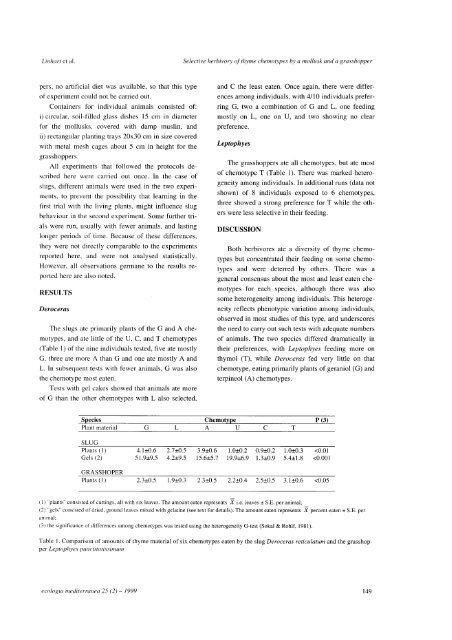Ecologia mediterranea 1999-25(2)
Ecologia mediterranea 1999-25(2)
Ecologia mediterranea 1999-25(2)
You also want an ePaper? Increase the reach of your titles
YUMPU automatically turns print PDFs into web optimized ePapers that Google loves.
Linhart et al. Selective herbivory ofthyme chemotypes by a mollusk and a grasshopper<br />
pers, no artificial diet was available, so that this type<br />
of experiment could not be carried out.<br />
Containers for individual animals consisted of:<br />
i) circular, soil-filled glass dishes 15 cm in diameter<br />
for the mollusks, covered with damp muslin, and<br />
ii) rectangular planting trays 20x30 cm in size covered<br />
with metal mesh cages about 5 cm in height for the<br />
grasshoppers.<br />
All experiments that followed the protocols described<br />
here were carried out once. In the case of<br />
slugs, different animals were used in the two experi<br />
ments, to prevent the possibility that learning in the<br />
first trial with the living plants, might influence slug<br />
behaviour in the second experiment. Some further tri<br />
als were run, usually with fewer animals, and lasting<br />
longer periods of time. Because of these differences,<br />
they were not directly comparable to the experiments<br />
reported here, and were not analysed statistically.<br />
However, all observations germane to the results re<br />
ported here are also noted.<br />
RESULTS<br />
Deroceras<br />
The slugs ate primarily plants of the G and A che<br />
motypes, and ate little of the U, C, and T chemotypes<br />
(Table I) of the nine individuals tested, five ate mostly<br />
G, three ate more A than G and one ate mostly A and<br />
L. In subsequent tests with fewer animals, G was also<br />
the chemotype most eaten.<br />
Tests with gel cakes showed that animals ate more<br />
of G than the other chemotypes with L also selected,<br />
and C the least eaten. Once again, there were differ<br />
ences among individuals, with 4/10 individuals prefer<br />
ring G, two a combination of G and L, one feeding<br />
mostly on L, one on U, and two showing no clear<br />
preference.<br />
Leptophyes<br />
The grasshoppers ate all chemotypes, but ate most<br />
of chemotype T (Table 1). There was marked hetero<br />
geneity among individuals. In additional runs (data not<br />
shown) of 8 individuals exposed to 6 chemotypes,<br />
three showed a strong preference for T while the oth<br />
ers were less selective in their feeding.<br />
DISCUSSION<br />
Both herbivores ate a diversity of thyme chemo<br />
types but concentrated their feeding on some chemo<br />
types and were deterred by others. There was a<br />
general consensus about the most and least eaten che<br />
motypes for each species, although there was also<br />
some heterogeneity among individuals. This heteroge<br />
neity reflects phenotypic variation among individuals,<br />
observed in most studies of this type, and underscores<br />
the need to carry out such tests with adequate numbers<br />
of animals. The two species differed dramatically in<br />
their preferences, with Leptophyes feeding more on<br />
thymol (T), while Deroceras fed very little on that<br />
chemotype, eating primarily plants of geraniol (G) and<br />
terpineol (A) chemotypes.<br />
Species Chemotype P (3)<br />
Plant material G L A U C T<br />
SLUG<br />
Plants (I) 4.1±0.6 2.7±0.5 3.9±0.6 1.0±0.2 0.9±0.2 1.0±0.3

















